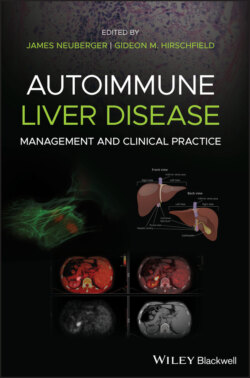Читать книгу Autoimmune Liver Disease - Группа авторов - Страница 36
Biochemical Markers and Patterns of Hepatic Injury
ОглавлениеContrary to the kidney, no single test can be used to assess liver function. The liver biochemical tests, or liver function tests (LFTs), provide indirect evidence of hepatobiliary disease. LFTs that more accurately reflect liver synthesis include serum albumin, serum bilirubin, and prothrombin time, which is standardized to the international normalized ratio (INR). The enzymes aspartate aminotransferase (AST) and alanine aminotransferase (ALT) are markers of hepatocellular disease, whereas alkaline phosphatase (ALP) and gamma‐glutamyltranspeptidase (GGT) are markers of cholestasis. The clinical evaluation of patients with abnormal LFTs involves an accurate interpretation of the pattern of liver damage in the context of an accurately collected medical history and physical examination. The severity and pattern of LFT abnormality, assessed by serial measurements, can be distinctive or aspecific. Different patterns of damage can be observed: hepatocellular damage, with predominant elevations in AST and ALT; cholestatic damage, with predominant increases in ALP, GGT, and bilirubin; and infiltrative damage with ALP and GGT increased disproportionately to bilirubin. These patterns are valuable in directing specific serologic tests, imaging, and liver biopsy. However, they are not diagnostic for a specific cause, nor are they able to distinguish whether cholestasis is intrahepatic or extrahepatic.
